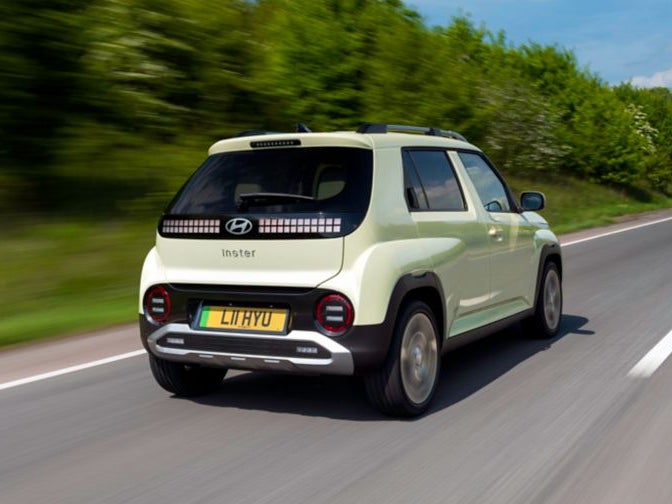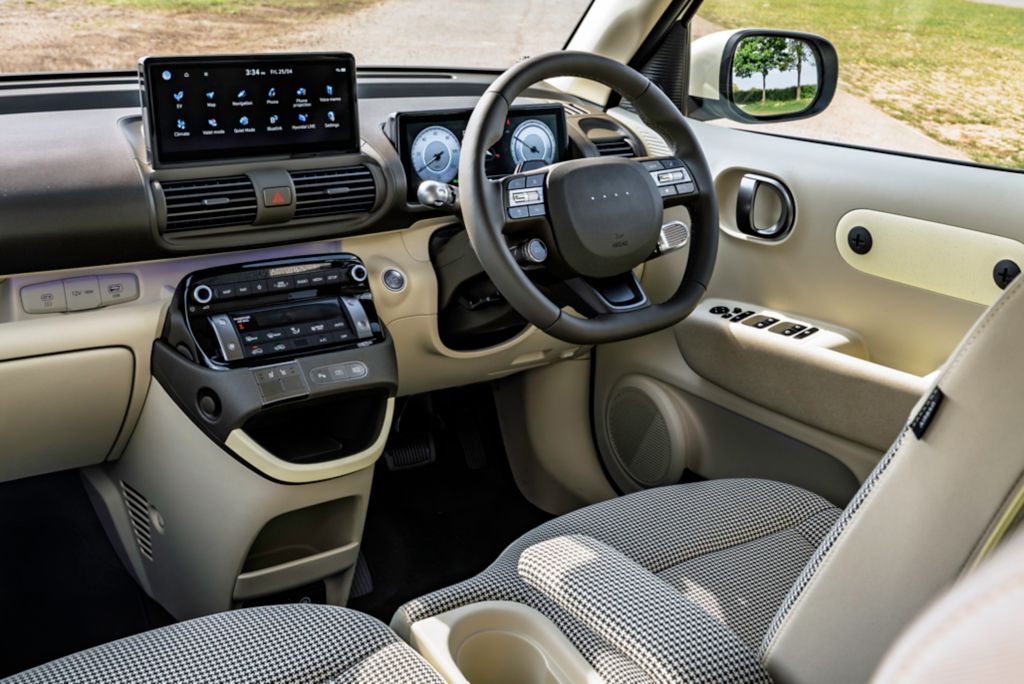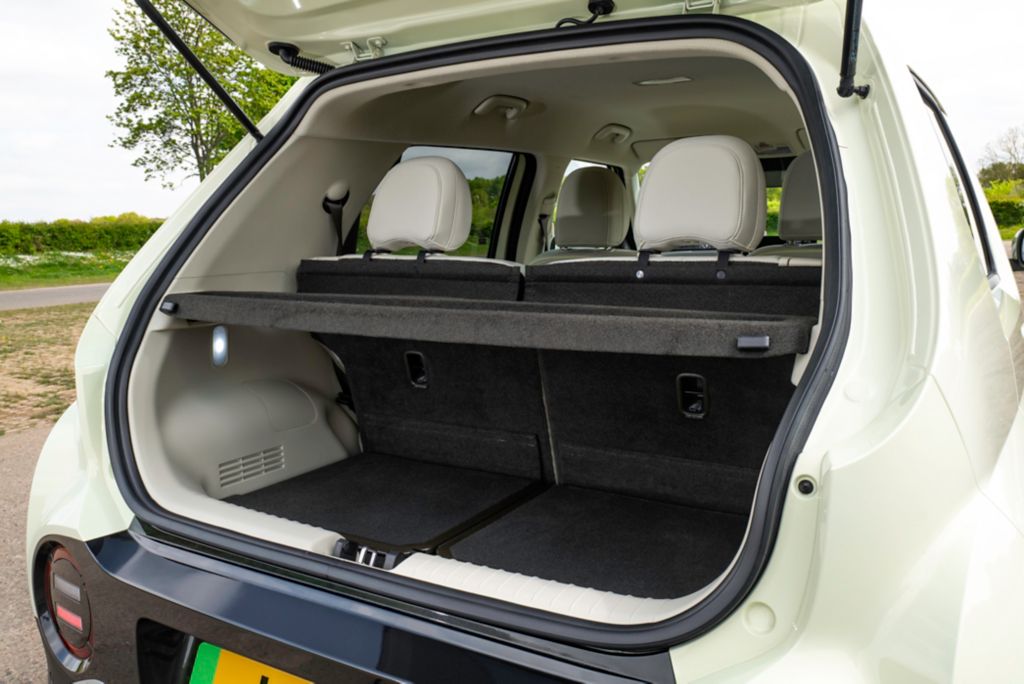
Hyundai hopes that the new electric Inster baby SUV could become a brand in itself. It has the slightly cuter Hyundai Casper name in its home market, where it’s also available with a petrol engine, but for us it’s only available as an EV with two batteries.
Previously, we’d have now gone on to tell you how much we like the Hyundai Inster, but how we thought it was too expensive. Now, though, Hyundai is offering the Inster with a discount of a whopping £3,750, whether it eventually becomes eligible for the government’s electric car grant or not. Now it has a starting price of just £19,755 for the Inster 01, considerably undercutting its big rival, the £22,995 Renault 5.
The Hyundai also gets a tech count that’s more at home in a premium car – and the car does come with essential EV kit like a battery heater and heat pump to boost efficiency in cold weather. With the new discounts the luxuriously kitted-out Inster 02 we drove would set you back just £23,005 plus a little bit more for one of the fancier paint options – about the same price as an entry-level Renault 5. There’s also the option of a faux-4x4 Inster, called the Inster Cross that gets even more kit for its new price of £25,005.
Given the Inster’s dinky dimensions, there’s a surprising amount of space in the back, while the tall shape means there’s loads of headroom. You can even fold all of the seats down – including the driver’s – stick a blow-up mattress in there and spend the night, there’s enough room.
However, the Inster EV is narrow – we found our shoulder rubbing up against the door pillar and our passenger sitting slightly closer than we might expect. But having spent more time recently in an Inster in the UK, we can live with that and just enjoy the comfortable drive, cute looks and extensive kit list.
Out on the road, the little Inster holds its own – it can keep pace with motorway traffic and, in true EV fashion, isn’t too noisy, while it was comfortable over our UK test route on some pretty rotten road surfaces.
It’s amazing how much a price realignment can change our opinion on a car. We always liked the Inster, but its price held it back. Now it has been transformed into one of our favourite small EVs.
How we test
We spent a week in an Inster doing many more miles than the average Inster owner would. We took it on long trips on the motorway where the car held its own, took it into London where its dimensions made parking a doddle, and we pottered around town with passengers in the surprisingly-spacious back seats and filled up the small boot.
Hyundai Inster: From £19,745, Hyundai.com

Independent rating: 9/10
Best for: Included kit
Battery, range, charging and performance
The cheapest Inster 01 comes with a 42kWh battery, while the 01 and lavishly kitted-out 02 models can be had with a 49kWh battery. There’s not a huge amount in it between the batteries; the smaller one gets a maximum claimed range of 203 miles, the larger one claims 223 miles.
Acceleration isn’t that different, either – neither car is speedy, nor do they need to be. The 42kWh battery gets from 0-62mph in 11.7 seconds and the 49kWh car does that in 10.6 seconds.
The 49kWh battery has a slightly higher fast charging speed at 85kW, the 42kWh battery will charge at a maximum of 73kW so not much to split the two there, either.
Our car with the bigger battery was enjoyable to drive around town with a good view out and a comfortable ride over the bumps – impressive given the car’s short wheelbase. It could hold its own on the motorway, too, while its efficiency impressed wherever you were driving – we suspect those range claims should be fairly realistic.
Interior, practicality and boot space
There are surprises and disappointments inside. Fold all the seats down – including the driver’s – and you could turn the Inster EV into a makeshift bedroom. And you’re unlikely to have anyone complaining about leg and headroom in the back, either. It feels pretty cavernous in the rear, with a good view out through deep windows.
We did notice something unusual up front, though. The Inster is narrower than many of its rivals so you sit very close to the side of the car and your front-seat passenger. Broader folk may well find themselves resting their shoulder against the door pillar which feels a bit odd these days. The door bins are laughably slim, too, although there is reasonable storage elsewhere in the cabin including a useful ledge in front of the passenger.
And much as the kit count is impressively high inside, the quality isn’t. It’s a shame Hyundai hasn’t just added a bit of fabric over some of the hard plastics, as Renault has done to good effect in the 5. The Inster’s dash design – despite two 10.25in digital displays for driver info and infotainment – looks a little dated, too, while the various sensors controlling the plentiful driver assistance and safety features are a bit too apparent behind the rear view mirror.
The boot offers a reasonable 238 litres of space – ideal for a few squashy bags – while moving the rear seats forward can release up to 351 litres of room in the boot.

Technology, stereo and infotainment
Who’d have thought such a small car would get adaptive cruise control (not that many Insters will spend their time on the motorway where it would be used most), climate control, two crisp and decently sized screens up front, LED headlights, privacy glass, 360 degree parking camera, heated seats and steering wheel, and keyless entry and start.
There’s also wireless smartphone charging, which we always find a little odd when you have to use a wired connection to get Apple CarPlay or Android Auto, which also charges your phone up.
The cluster of sensors you can see behind the rear-view mirror reveal the sheer number of advanced driver assistance features you get including that adaptive cruise control, lane keeping assistance and the like, while sensors will automatically put the lights or wipers on for you, too.
The audio system on our car wasn’t especially impressive, though, but will probably do for most people on shorter journeys.
Prices and running costs
The Inster is a clear step ahead of all-electric budget car rivals like the Dacia Spring and Leapmotor T03 at the cheaper end of the city car market and more of a rival to the Renault 5 and BYD Dolphin Surf. Its new pricing – assuming Hyundai’s generous electric grant stays in place – now gives the Inster a real advantage over its rivals.
There a lot else to like about the Inster, too, not least its efficiency. We were impressed by how little battery energy had been used over our mixed road test route, so running costs should be super-cheap. And, of course, you get the reassurance of Hyundai’s impressive five-year warranty.

Hyundai Inster’s electric car rivals:
FAQs
How much does the Hyundai Inster EV cost and is it worth it?
With Hyundai’s electric grant in place saving you £3,750, the price of the Inster isn’t the issue it once was. It’s great value from £19,745 to £25,005.
How long does it take to charge?
For such a small car, charging speeds are reasonably impressive with the 49kWh battery model getting a slightly higher fast charging speed at 85kW, the 42kWh battery will charge at a maximum of 73kW. That means both will do a 10 to 80 per cent charge in around 30 minutes on a suitable fast charger.
Does Hyundai replace batteries for free?
Hyundai offers an eight-year, 100,000-mile warranty on the battery and – as long as the car has been properly maintained in that time – will repair or replace batteries with any issues.
Why trust us
Our team of motoring experts have decades of experience driving, reviewing and reporting on the latest EV cars, and our verdicts are reached with every kind of driver in mind. We thoroughly test drive every car we recommend, so you can be sure our verdicts are honest, unbiased and authentic.
The verdict: Hyundai Inster EV
The Inster is an electric car you’ll love due to its cute 4x4-ish looks and the generous kit count on board. There’s a surprising amount of space for the family on board, though, and the kit list is more akin to what you’d expect in a bigger, much more expensive model. At the new prices, the Inster is a real winner.







